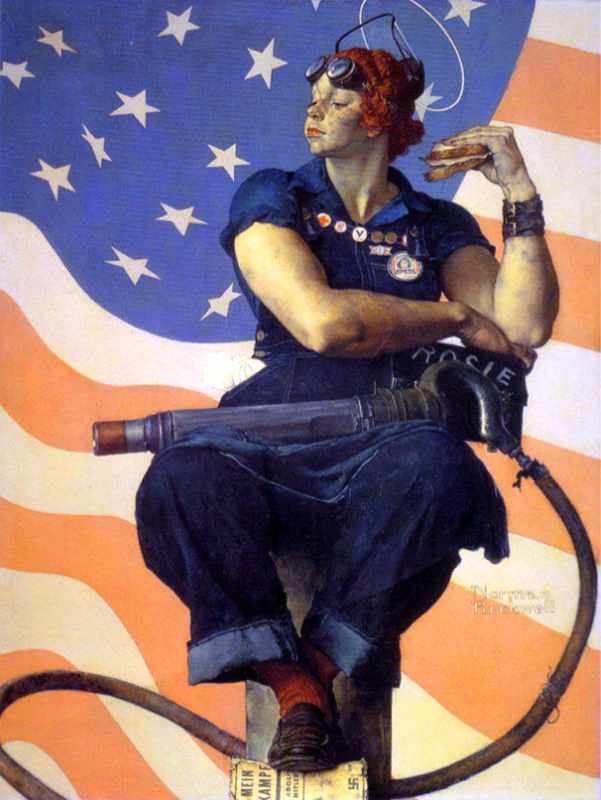Rosie the Riveter is an allegorical cultural icon in the United States who represents the women who worked in factories and shipyards during World War II, many of whom produced munitions and war supplies. These women sometimes took entirely new jobs replacing the male workers who joined the military. Rosie the Riveter is used as a symbol of American feminism and women’s economic advantage. The idea of Rosie the Riveter, and the name, originated in a song written in 1942 by Redd Evans and John Jacob Loeb. The song was recorded by numerous artists, including the popular big band leader Kay Kyser, and it became a national hit. It was also recorded by the R&B group, The Four Vagabonds. The song portrays “Rosie” as a tireless assembly line worker, who earned a “Production E” doing her part to help the American war effort. Images of women workers were widespread in the media, in formats such as government posters, and commercial advertising was heavily used by the government to encourage women to volunteer for wartime service in factories. In 1942, Pittsburgh artist J. Howard Miller was hired by the Westinghouse Company’s War Production Coordinating Committee to create a series of posters for the war effort. One of these posters became the famous “We Can Do It!” image, an image that in later years would also be called “Rosie the Riveter” although it had never been given that title during the war. Norman Rockwell’s image of “Rosie the Riveter” received mass distribution on the cover of the Saturday Evening Post on Memorial Day, May 29, 1943. Rockwell’s illustration features a brawny woman taking her lunch break with a rivet gun on her lap and beneath her penny loafer a copy of Adolf Hitler’s manifesto, Mein Kampf. Her lunch box reads “Rosie”; viewers quickly recognized that to be “Rosie the Riveter” from the familiar song. Rockwell, America’s best-known popular illustrator of the day, based the pose of his “Rosie” on that of Michelangelo’s 1509 painting Prophet Isaiah from the Sistine Chapel ceiling. Rosie is holding a ham sandwich in her left hand, and her blue overalls are adorned with badges and buttons: a Red Cross blood donor button, a white “V for Victory” button, a Blue Star Mothers pin, an Army-Navy E Service production award pin, two bronze civilian service awards, and her personal identity badge. The Post’s cover image proved hugely popular, and the magazine loaned it to the United States Department of the Treasury for the duration of the war, for use in war bond drives.
| Alias Rosie the Riveter |
| Real Names/Alt Names Rosie |
| Characteristics Hero, Patriot-themed, World War II Era |
| Creators/Key Contributors J. Howard Miller, John Jacob Loeb, Norman Rockwell, Redd Evans |
| First Appearance “Rosie the Riveter” (Song, 1942) |
| First Publisher ○ |
| Appearance List Song: “Rosie the Riveter” by Redd Evans and John Jacob Loeb (1942). Poster: “We Can Do It!” by J. Howard Miller (Westinghouse Company’s War Production Coordinating Committee, 1942). Painting: “Rosie the Riveter” by Norman Rockwell (Saturday Evening Post, Memorial Day, May 29, 1943). Film: Rosie the Riveter (1944). Comics: War Victory Comics #3, Green Hornet #16, All-New Comics #10, Super-Dooper Comics #8. |
| Sample Read Norman Rockwell, Rosie the Riveter [YT] |
| Description Rosie the Riveter is an allegorical cultural icon in the United States who represents the women who worked in factories and shipyards during World War II, many of whom produced munitions and war supplies. These women sometimes took entirely new jobs replacing the male workers who joined the military. Rosie the Riveter is used as a symbol of American feminism and women’s economic advantage. The idea of Rosie the Riveter, and the name, originated in a song written in 1942 by Redd Evans and John Jacob Loeb. The song was recorded by numerous artists, including the popular big band leader Kay Kyser, and it became a national hit. It was also recorded by the R&B group, The Four Vagabonds. The song portrays “Rosie” as a tireless assembly line worker, who earned a “Production E” doing her part to help the American war effort. Images of women workers were widespread in the media, in formats such as government posters, and commercial advertising was heavily used by the government to encourage women to volunteer for wartime service in factories. In 1942, Pittsburgh artist J. Howard Miller was hired by the Westinghouse Company’s War Production Coordinating Committee to create a series of posters for the war effort. One of these posters became the famous “We Can Do It!” image, an image that in later years would also be called “Rosie the Riveter” although it had never been given that title during the war. Norman Rockwell’s image of “Rosie the Riveter” received mass distribution on the cover of the Saturday Evening Post on Memorial Day, May 29, 1943. Rockwell’s illustration features a brawny woman taking her lunch break with a rivet gun on her lap and beneath her penny loafer a copy of Adolf Hitler’s manifesto, Mein Kampf. Her lunch box reads “Rosie”; viewers quickly recognized that to be “Rosie the Riveter” from the familiar song. Rockwell, America’s best-known popular illustrator of the day, based the pose of his “Rosie” on that of Michelangelo’s 1509 painting Prophet Isaiah from the Sistine Chapel ceiling. Rosie is holding a ham sandwich in her left hand, and her blue overalls are adorned with badges and buttons: a Red Cross blood donor button, a white “V for Victory” button, a Blue Star Mothers pin, an Army-Navy E Service production award pin, two bronze civilian service awards, and her personal identity badge. The Post’s cover image proved hugely popular, and the magazine loaned it to the United States Department of the Treasury for the duration of the war, for use in war bond drives. |
| Source Rosie the Riveter – Wikipedia |



